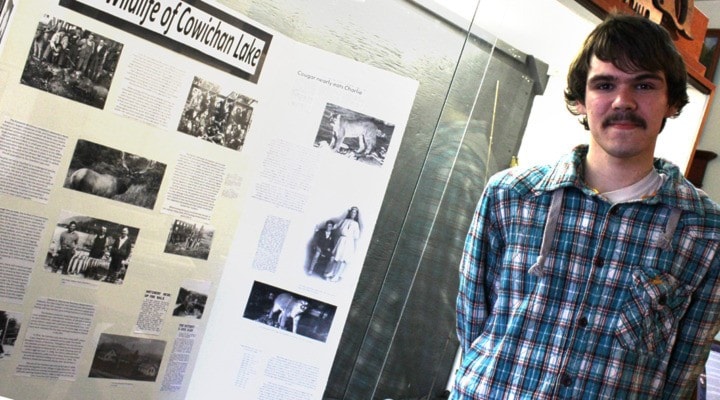Jack Siemens is a biology student studying at the University of Victoria, but he has also been the student employee at the Kaatza Station Museum over the summer.
Siemens was born in Duncan, but lived in Haida Gwaii for a number of years before returning to the Cowichan Lake area. Over the summer he has been residing in Youbou.
He took the job at the museum because he didn’t want to flip burgers all summer.
Siemens says he has gained some valuable skills working at the museum.
“Definitely gotten better at doing any sort of research that’s not over the computer. Before, my skills in that were rather lacking, I usually put off any sort of look-in-the-library-for-what-you-need-to-find at UVic.”
He also says he has developed better people skills.
“I’ve never been super confident around dealing with strangers. It’s not like I’m a social cripple or something like that, but meeting new people had never been my strong point, but I’m better at that now.”
On Aug. 27, Siemens had his last day at the museum before heading back to Victoria for the fall semester. As one of his final tasks, Siemens put together a display, which is now featured in the main building of the museum.
The display focusses on the history of the wildlife around Cowichan Lake. Siemens picked the subject because it relates to his degree.
“It’s about the state of how the wildlife were when the Cowichan Lake area was first colonized and sort of how its affected the growth of the community.”
He says that the wildlife in the area was one of the major attractions that first drew pioneers to the area.
“And it’s basically been one of the major sources of our tourist industry ever since. Logging, fishing in the lake, and hunting are basically the top three reasons why people actually come to Lake Cowichan.”
In his display, Siemens focussed for the most part on wolves, bears, cougars, elk, and of course, fish.
He was curious about the wolf population because he had heard stories, but had not come across anyone who had actually seen any wolves in the area.
He says that a friend called up the conservation office.
“And it turns out that yes, there is one wolf pack that sort of roams between here and Port Renfrew. So that’s the reason people see them every now and again,” Siemens explained.
For his research, Siemens relied on museum archives, but he also sourced information from Duncan and the surrounding area.
“The downside is that it turns out we don’t actually have a lot of artifacts that relate to hunting or wildlife. We’ve got some fishing wands, not much else,” said Siemens.
“Instead of hunting rifles or anything like that, which I kind of expected somebody to donate, instead we’ve got swords.”
Siemens says that most of the time spent putting together the display was spent making sure that all of the finishing touches were completed. The rest of his time was spent researching and hunting down pictures and news articles.
“The only thing that took any sort of amount of [continuous] time was writing up all of the articles,” said Siemens. “And that didn’t take that long because I’m a relatively fast writer.”
Siemens’ display can be viewed during the now resumed winter hours which are 10 a.m.-4 p.m., Tuesday to Saturday through until Dec. 16.
